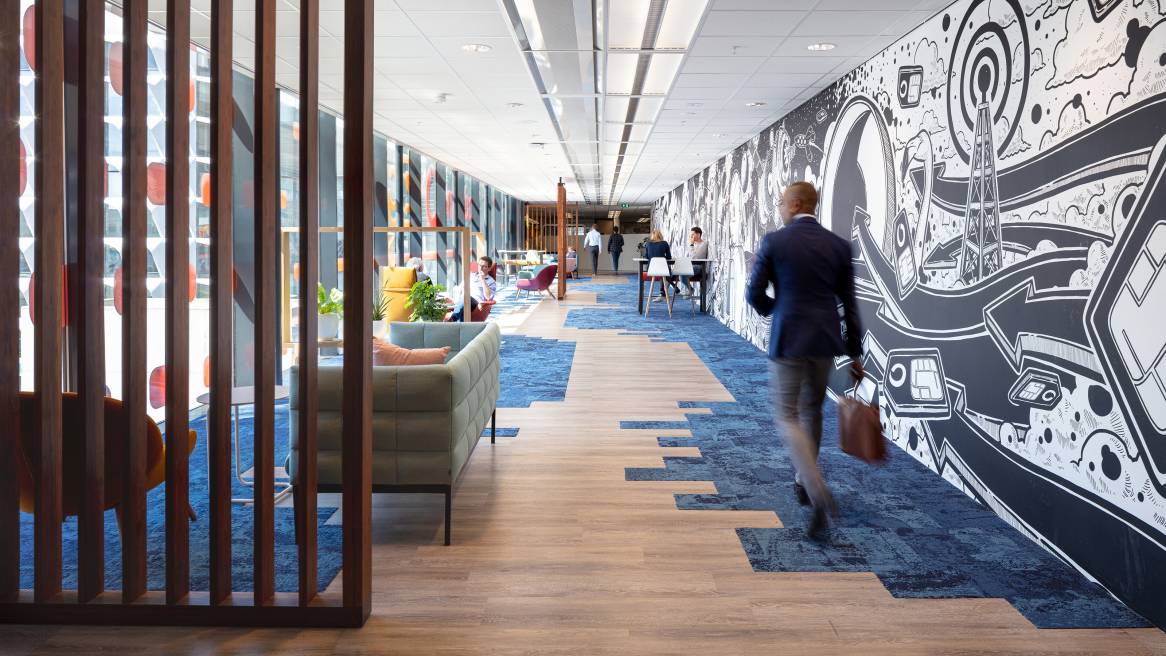One Company with One Way of Working
VodafoneZiggo’s New Central Office Successfully Merges Workplace Cultures
When global telecommunications company Vodafone merged its Dutch business with Ziggo, the country’s largest cable provider, one of the biggest challenges company leaders faced was internal: joining two very different workplace cultures. While all Vodafone employees, including its leaders, had become highly mobile with all-unassigned workspaces and the ability to work wherever they wanted, Ziggo relied on assigned workstations in the open plan and private offices for its executives.
When two cultures are so different, a merger can be very disruptive. An “us vs. them” dynamic can easily develop, creating tensions that undermine whatever synergies the merger was supposed to achieve. From the onset, VodafoneZiggo leaders wanted to minimize that threat. Their aim was to create a single company with one ambition and one way of working – to combine the best of both companies in order to create a new, merged story. The workplace wasn’t an afterthought in achieving that goal. Instead, it anchored the strategy.
Rather than focusing on site rationalization as a necessary routine to achieve economies of scale, VodafoneZiggo leadership understood the vital importance of creating a new central office that would leverage the power of space to successfully blend both companies into a new and vibrant shared culture. They recognized the crucial importance of creating a workplace that would enhance all employees’ feelings of belonging and connection.
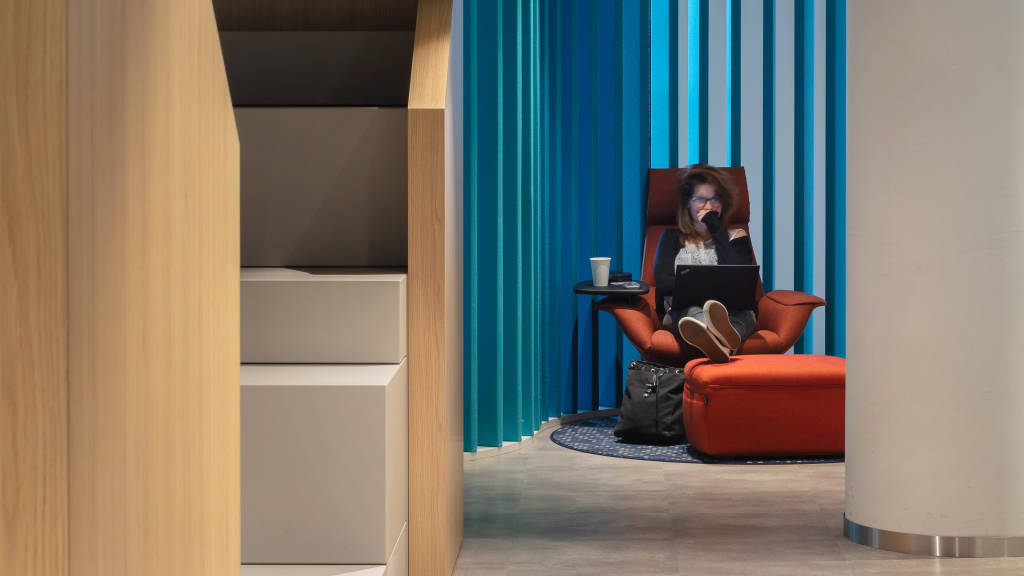
An urban dynamic of individuality and interdependence inspired the design of the new facility.
“We knew that everything we did from the merger onward would need to deal with our ambition of being one company with one way of working. There would be no ‘old days’ anymore,” says Roel Polmans, project lead. “We wanted to create an office space where you don’t need to be but rather would want to be because it’s more engaging, it’s more productive and it’s more enjoyable.” In addition, leaders wanted to be sure that the image of innovation reflected in the Vodafone and Ziggo external brand images was also authentically experienced by employees every day on the job.
Adapting to People
Using design thinking methodology, the project team conducted in-depth workshops at the very beginning of the project involving a wide range of employees. The goal was to develop empathy and gain essential insights into employees’ wants and needs – how they were spending their time on what kinds of work, as well what kind of environments were desirable to them. It was clear from the onset that the new VodafoneZiggo office needed to be a human-centered place that could adapt to how employees really want to work — not the other way around. The workshops were also opportunities to help employees understand the changes they’d be experiencing in their new workplace, and the reasons behind the changes. “If you expose people to this new way of working before moving in, then they’re likely to really feel and understand what it is,” Polmans explains.
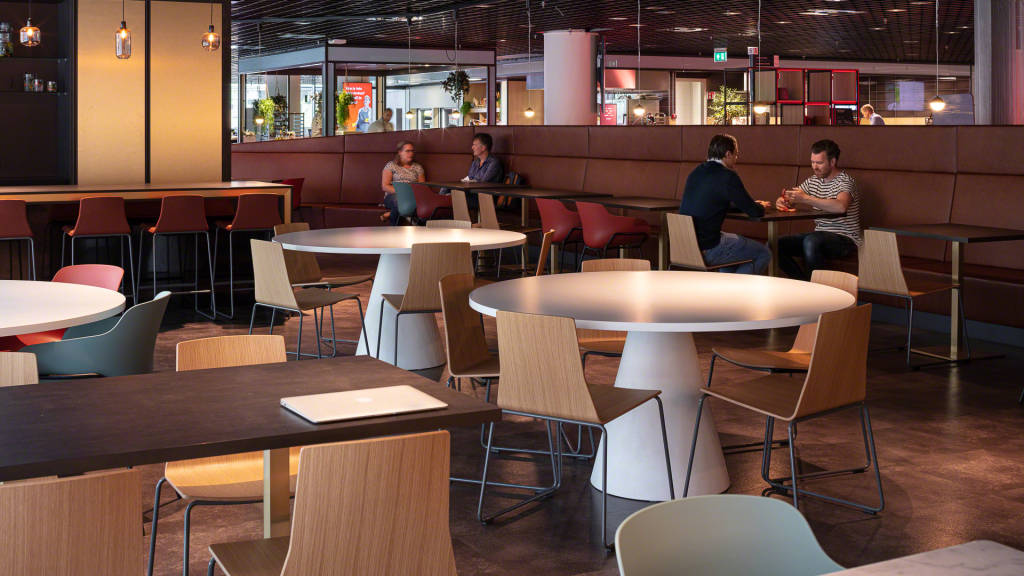
One year later, more than 1,500 VodafoneZiggo employees in the Netherlands moved into a stunning, 18.000m2 total renovation of three buildings in the center of Utrecht. Directly opposite the central train station, it’s an ideal location for the majority of employees who now commute via public transportation in sync with their company’s new sustainable mobility plan.
Formerly a dingy five-story mall, the new VodafoneZiggo central office grabs the attention of every passersby with an eye-catching sculptural metal grid on its entire façade, specially shaped to let natural sunlight through the windows behind it while controlling glare. The ground floor is a bustling shopping center that includes a flagship VodafoneZiggo retail space, visibly reminding employees every day of their connection to customers and brand. The second floor is a customer welcoming area and an experience center, a place where customers, partners and other stakeholders can explore product solutions and become inspired about how VodafoneZiggo can help them progress.
How the Magic Happens: Choice & Control
The upper three levels are employee spaces, purposefully connected with a large central staircase in an open atrium that provides a constant view of the customer floors below. This is a place where employees often serendipitously cross paths, creating opportunities for work-related discussions as well as cohesive socializing – “a simple way for people to meet each other,” explains Tim Merkenhof, OCS+ workplace consultant and concept designer.
A glass bridge connecting separate buildings is another place for impromptu and scheduled conversations. Offering an inspiring lookout view of downtown Utrecht, it’s become one of the most-used meeting spaces; people in different buildings just walk over and meet on the bridge.
This new central office is a totally free-address, shared work environment. People can choose where they want to be in the space. Although each department has its own designated homebase, everyone can find their best work environment anywhere – from open areas to enclosed private pods to collaboration spaces to casual lounge settings, depending on their needs and mood. “We felt that people needed a connection to a specific space in the building, but we also didn’t want to restrict anybody,” explains Merkenhof.
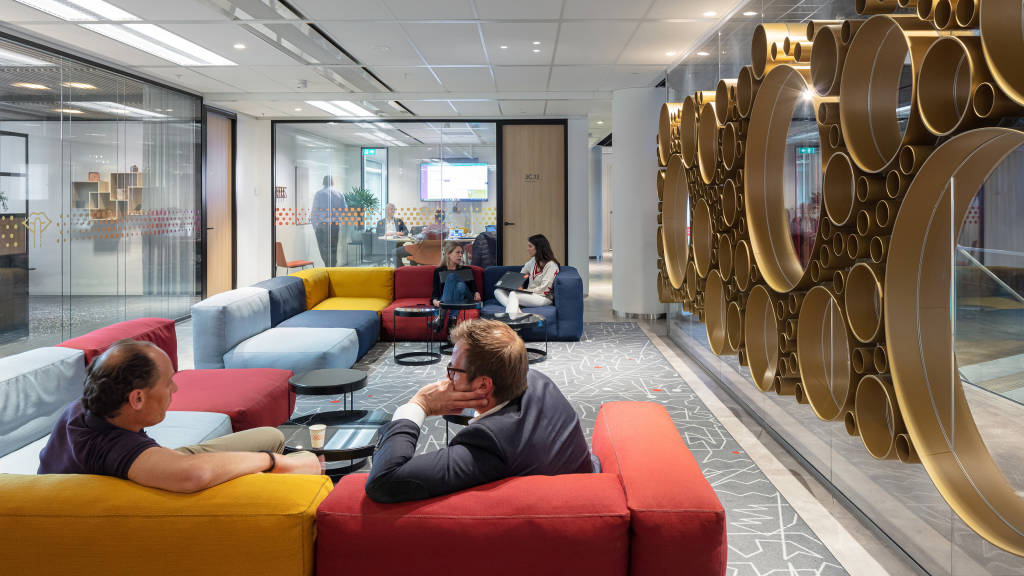
Even executives don’t have an assigned office and instead enjoy the wide-ranging diversity of spaces. “Leveling hierarchy is really an essential thing for our culture. Here, we all breathe the same air as all part of the same company,” says Polmans.
Inspired by Urban Dynamics
With so many employees now working together every day, Polmans observes, “we are like our own society.” And, in fact, the urban dynamic of individuality and interdependence is what inspired the design of the new facility, notes Merkenhof. Different zones meet distinctly different needs.
Large central areas surrounding the staircase are lively places for impromptu meetings and spur-of-the-moment chats. “Instead of waiting two weeks for a meeting, you can settle things in two minutes,” notes Polmans.
Ringing these centers is a buffer zone that includes amenities such as lockers, printers, coffee bars and large meeting rooms, functioning like transportation systems that route people throughout the building. Farther out are neighborhoods, quieter places for individual and collaborative work, including some “streets” especially designated for agile teams that are complete with both stand-up and sit-down huddle areas, abundant whiteboards and technologies. Work-in-progress is prominently displayed so anyone in the company can see what’s underway and contribute ideas. “We completely changed the rules of how you work in the office here so teams can understand the way agile works and gain the benefits of it,” says Merkenhof. Since move-in, the number of agile teams has grown from 20 to more than 50.
On the top floor, there’s an expansive WorkCafé – a place to eat, drink, work together and socialize. Various gaming options make this a gathering place to connect and recharge. The WorkCafé also hosts town-hall meetings and other employee events.
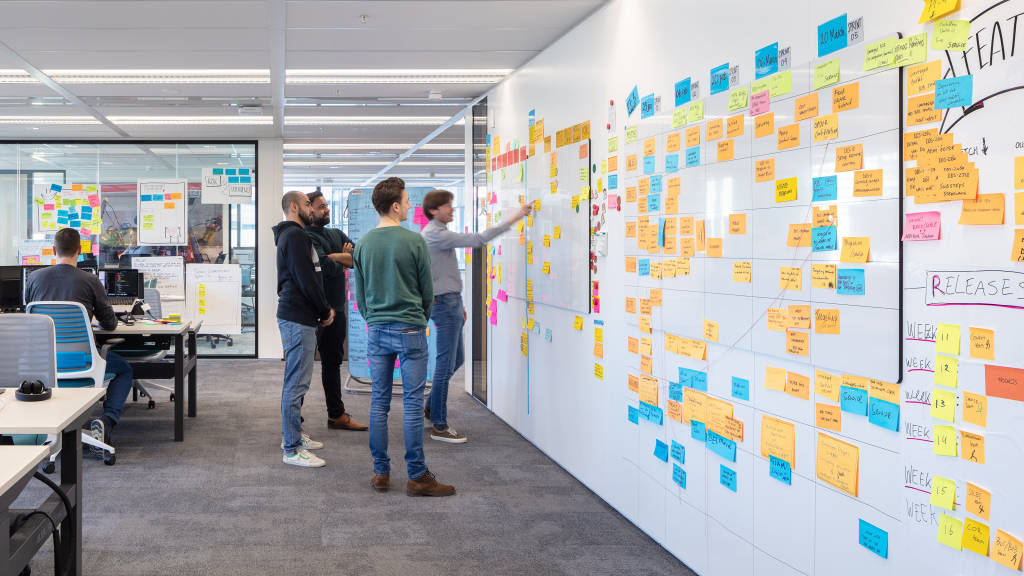
To encourage mobility, designers planned on three chairs for every employee: one in an individual work zone, another in a collaboration zone and a third is a social zone.
At the same time, “every seat in the whole office is a workspace,” says Merkenhof. “For example, you can eat in the WorkCafé but you can also work in the WorkCafé. There are meeting spaces, but you can also do individual work there. This is how the magic happens in terms of creating a mix of spaces where you have the choice and control.”
Always Evolving
With bright pops of color and an abundance of textural interest, the buzz of the entire space is intentionally welcoming, comfortable and invigorating without being frenetic. Some even describe it as “homey.”
We wanted to bring office life to the next level, to bring in the purpose of our new company.
“It tells something about who we want to be as a company. We wanted to bring office life to the next level, to bring in the purpose of our new company, which is ‘Enjoyment and progress with every connection,’” notes Polmans, quickly adding that achieving that goal goes beyond aesthetics and game rooms. “The most important thing for most people at work is, do they feel at ease? Can they find the proper place to work? Can they find their colleagues? A meeting room? Places to leave their stuff? Get lunch? If all the basics are done right, then people are going to love it.”
As forward-facing as this workplace is today, it was designed to be flexible. Already, some spaces have been adapted to support the growth of agile teams. As Merkenhof explains it, “A good office is never finished. It’s constantly evolving according to the wishes and needs of the user.”

